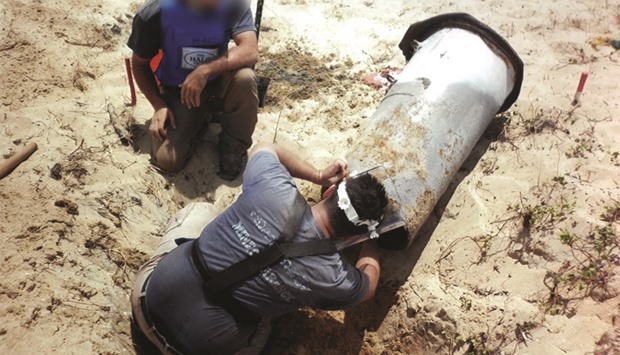Images that appear to confirm the use of cluster bombs in the end stages of Sri Lanka’s 26-year civil war have been uncovered as new testimony emerged suggesting the country’s armed forces may have deployed the munition against civilians.
The revelations are likely to prompt serious questions for the current Sri Lankan government, which includes several senior members of the cabinet who oversaw army activity during the last days of the conflict.
The photographic evidence provided to the Guardian depicts cluster bombs uncovered by de-mining teams in parts of the country close to sites where fighting took place in late 2008 and early 2009.
Some of former de-miners claim they identified munitions within government-declared “no fire zones” in which about 300,000 people were told to gather for their safety during the war’s denouement.
The Sri Lankan civil war, which lasted from 1983 to 2009, pitted the country’s military against the separatist rebel force known as the Liberation Tigers of Tamil Eelam (LTTE) which had waged an armed campaign to achieve an independent state for the ethnic Tamil community in the north and east of the island nation.
The conflict is estimated to have claimed upwards of more than 100,000 lives, many of them in the final months of fighting which occurred in and around the northern Vanni region.
The photographs of cluster bombs were leaked to the Guardian New Service by a former employee of the Halo Trust, the world’s largest mine clearance organisation. The images appear to show members of the trust digging out a large delivery missile as well as cluster sub-munitions, or “bomblets,” in different locations.
Independent corroboration of the nature of the weapons has been provided by a senior weapons researcher at Human Rights Watch who identified the material pictured as the remnants of Russian-made cluster bombs and unexploded cluster sub-munitions.
The revelations come as the 32nd session of the Human Rights Council opened last week in Geneva, at which the Sri Lankan government is to be questioned on its progress to provide accountability for alleged war crimes committed during the war’s close.
Reports produced by the United Nations and several rights groups have found that war crimes and possible crimes against humanity may have been committed by Sri Lankan forces.
Towards the end of the war, while closing in on the LTTE’s last redoubts in the vicinity of Puthukudiyiruppu and Mullaitivu, the government advised civilians to gather in a series of “no fire zones” – areas which the Sri Lankan army promised it would not attack. The location of the safe zone shifted three times, moving from an initial 52sq km block around the area of Suthanthirapuram to a narrow strip of coastland, which shrunk even further as the army made gains.
Reports by the UN and other agencies cite evidence and credible allegations of atrocities committed within these supposedly protected areas: government forces are accused of relentlessly shelling the zones, leading to up to 70,000 deaths, while the LTTE are alleged to have used human shields and shot at fleeing civilians.
The previous Sri Lankan government has denied allegations it used cluster bombs and Sirisena has maintained that the army acted in “adherence to international law”.
He has committed himself to holding a war crimes tribunal in Sri Lanka, but has so far resisted calls to conduct such a hearing in a “hybrid” court that would involve both Sri Lankan and international legal experts, as recommended by a UN report released in 2015.
A spokesperson for the Halo Trust acknowledged it had found a total of 42 cluster munitions in several sites around the Pachchilapalli area, near Elephant Pass, slightly to the north of the Vanni region, in 2011 and 2012.
The source for the photographs, who now lives outside Sri Lanka, said the images depicted munitions discovered in the Kilinochchi district and also near Chalai, to the north of Mullaitivu. Both Chalai and parts of Kilinochchi district were also sites of fierce battles in the final months of the conflict.
Ex-workers at Mines Advisory Group (MAG), the Halo Trust and the Swiss Foundation for Mine Action (known by its French-language acronym FSD) have said they saw evidence of the use of cluster bombs in the final days of the war, with representatives from the final two saying cluster bombs were found in one of the government-declared no fire zones.
Only the Sri Lankan air force and army are believed to have had the capability to deploy cluster bombs in the no fire zone; the LTTE did not undertake aerial attacks in the area.
Former officials in two de-mining organisations said that cluster munitions were positively identified.

Remnants of what appears to be an RBK-500 AO-2.5RT cluster bomb uncovered in Chalai, near Mullaitivu.
